
Who Were
The Cambs
The Cambs
at War
1/1st Btn 1914-1919
1914 - 1/1st Overview
1915 - 1/1st Overview
1915 - St Eloi
1915 - Fosse Wood
1916 - 1/1st Overview
1916 - The Schwaben
1916 - St Pierre Divion
1917 - 1/1st Overview
1917 - St Julien
Insignia, Medals & Books
Remembering The Cambs
Biographies
About Us &
This Site
Medal Frequently Asked Questions
Since the launch of this site and at the many family history events we attend we are regularly asked questions about medals. The following FAQ has been written by a member of the team who is a very experienced and long-time medal collector and it is aimed at providing people with as neutral and unbiased guide as possible. Collectors have different approaches to many of the questions below and we have tried to cover both sides as best as possible. In regards to the sale of medals, again we have tried to explain the more common options open to people and the pros and cons for each of them.
For information and assistance with identifying First World War medals then we have a helpful online guide that can by found by clicking here. If you are looking for more specific information or have any questions not covered below then please contact us at the site email address: cambsregt@gmail.com
Should I Clean My Family Medals?
Whether to clean or not to clean is an issue that divides many medal collectors and is a question often asked by owners of family medals. The simple answer really is: it’s your choice, as the current owner, or custodian of the medals. Some people like the dark patina which occurs when medals are not cleaned, but others are conscious that soldiers themselves never wear tarnished medals and prefer them to be bright and shiny. However, there are some things it’s useful to know when making that decision. Medals are made from a variety of metals and it is important to have an understanding of these before you try to clean them, and great care should always be taken. If you use the wrong cleaner on a medal you may irrevocably damage the surface and spoil the appearance of the medal, and reduce its value. Certain medals have gilt washes or a bronzed finish and cleaning of these should be kept to an absolute minimum.
Modern medals, such as the majority of campaign medals issued by the UK government after about 1980 and several of the WW2 medals, are made of cupro-nickel and can easily be damaged by abrasive cleaners. A clean with soap and water, careful drying and a buff with a soft cloth is all that should be undertaken by novices with regard to these medals. Medals from before this date are usually made from silver, silver gilt, brass or bronze and can be carefully cleaned with the correct cleaner for the correct type of metal. Once cleaned, they should be rinsed in water with soap to remove any polish residues, dried thoroughly and then gently buffed with a soft cloth.
Dipping solutions, such as Goddard's silver dip are excellent because they clean into all the crevices and fine detail of the medal without the need to brush or polish heavily but care should be taken not to leave medals in the solutions for too long and not to dip gilded medals because the gilding might be removed by the cleaning agent. Some over the counter brass cleaners are ok for the brass or bronze medals but should be applied only with a cloth, cotton bud or very soft brush and it should be noted that the colour of the medal will change as a result of the cleaning and some cleaners can be abrasive so seek advice if you are at all unsure. Care should be taken to remove any residue of polish because as they dry many brass cleaners will be visible as a white or greenish powdery mark.
Whatever your preference, cleaning should really be kept to a minimum, excessive polishing will remove the clarity of the detail of the medal and may introduce scratches to the medal surface which again will detract from both its aesthetic appearance and its value. However, where the medal is marked with dirt or verdigris, damage will occur if it is left so cleaning it will improve its appearance and prevent further decay of the metal so should be undertaken. If you have medals that are mounted as worn it is quite difficult to clean these properly without making the ribbons dirty so extra care should be taken, or new ribbons could be fitted at this stage if desired.
Should I Put New Ribbons On My Medals?
Ribbons are another subject that divides medal collectors. Some will keep medals on old and tatty ribbons whereas some will replace ribbons as soon as they acquire the medal. Again, it is really a matter of preference, especially for owners of family medals. The only over-riding factor is the protection of the medals themselves. If the medals are likely to be worn or displayed suspended then they should hang securely on good quality ribbons to prevent them falling off and becoming lost or damaged.
Some medal collectors prefer medals on “original” ribbon, regardless of its appearance and that’s perfectly OK, except it’s very difficult to know with an old medal whether the ribbon is genuinely “original” or not. If your medals are mounted on a suspension bar for wearing, or are as they were worn by your family member, you may choose to keep them that way and many collectors would echo this view, provided they are secure. Court mounting, where the medals are stitched to a completely ribbon wrapped board is often very secure, and an attractive method of mounting, but does make cleaning quite difficult.
If you decide you would like to replace ribbons for your medals they can be easily and cheaply acquired from a local medal shop, or from many outlets online. It is worth consulting a reference source to check that the ribbon you are replacing is the correct one and if the pattern isn’t symmetrical that you have it the right way round (or click here for a guide to the more common WW1 medals). Many medals are double sided and there is a correct side which should face up, known as the obverse, and where you have more than one medal in a group there is also a correct order of wear. Again, your local medal shop or online resources will be able to guide you here.
There are many companies offering a medal mounting service and whilst the majority are reputable others may not be. Before you send your precious medal group away for mounting check the company out, and photograph the medals before you send them, making particular note of any naming that appears on the reverse or rim of each medal. Medal mounting firms are often also medal dealers too and may make you an offer for the medals when you ask about mounting, if you have no wish to sell the medals don’t be afraid to make that clear to them.
Can I Wear Family Medals?
Officially speaking, only the recipients are entitled to wear medals. However, after the First World War widows started wearing their husband’s medals to publically demonstrate their loss, a practice few would criticise. Over time this has developed into a trend for family members to wear their relative’s medals, but on the right breast. Again, it is difficult to be critical of this practice but when numerous medal groups are worn by one person it can be seen to diminish their importance. It is a criminal offence to wear medals with the intention to deceive so officially medals should only be worn on the left breast by the recipients, and unofficially on the right breast (in moderation) by relatives.
A recent trend for unofficial or commemorative medals has also developed and without a doubt these diminish the value of official medals and serving personnel are not permitted to wear them. Arguably, it is acceptable for old soldiers to wear these to denote a particular battle within a large campaign for which they were awarded a generic campaign medal, but for personnel who are not entitled to any medals to wear these only to be seen to be wearing medals is close to deception and should be avoided.
How Should I Store My Medals?
This largely depends on what you want to do with them. If you have been awarded medals or have family medals and intend to wear them they should be kept securely, in a box, wrapped in a clean cloth in such a way as to prevent their clinking together or rubbing against each other. If you have a small sachet of silica gel (they often come in shoeboxes with shoes) you could keep this in the box as well to absorb any moisture.
Some people choose to frame their own or family medals and this is an excellent way to enjoy or display them. Ribbons will fade in direct sunlight and thieves may see them so it is a good idea to hang framed medals out of view of windows and not in direct sunlight. It is also worth bearing in mind that framed medals will tarnish over time so what starts out as a very nice shiny display will eventually change to contain darker toned medals, and may not be what you had envisaged when you paid for them to be framed. It is possible to apply a varnish to medals to stop them tarnishing but this is a fairly specialist field and should be approached with caution.
If you have medals that you don’t intend to wear and don’t intend to display they should be kept securely in a dirt and moisture free environment. Medals that are in groups shouldn’t be split or separated as their value and historical importance is increased by being part of a group and if you have papers about or photographs of the recipient it is a good idea to keep these with the medals adding the names known of any people in photographs. Telling family members where medals are kept is a good idea and prevents the inadvertent loss of medals when houses are emptied by house clearance companies after family members die. It is also a good idea to photograph medals, including the naming, or note this down so that you have it for reference purposes.
How Much Are My Medals Worth?
All medals have a value and it is very useful to know what it is, even if just for insurance purposes. Collectors will normally know what the values of their medals are but families who have ancestors’ medals will often have no clue as to the value of the medals in their possession. This will often manifest itself in one of two ways, either they substantially undervalue them, or they think they are worth significantly more than they really are. Either way, medals to family members, especially those that are named are usually irreplaceable so the actual monetary value is often only a guide for insurance purposes. However, it is important to remember that the value of medals is a very subjective thing, and just because you see a similar medal sell for a given figure won’t necessarily mean your medal is worth the same.
Each individual medal will have a rough market value based on its rarity or the campaign it was awarded for but in addition to this there are then other factors that dictate which end of the market value it is, such as which service or regiment the recipient was in, where exactly within a campaign they actually served, whether they were a casualty, what rank they were and whether the medal is part of a group. Medal collectors are often interested in the story that comes with the medals, provided it is supported by research or documentation.
Rarer medals, such as gallantry awards, or orders of chivalry in groups will increase the value, but damage to the medals or incomplete groups will often reduce the value. In the UK medals are highly collectable and whether one agrees philosophically with this or not doesn’t change that fact, and some medals, such as Victoria Crosses, are worth extremely large sums of money but the majority of medals have far more modest values.
There are a number of ways to work out the value of medals, the first and principal way is to consult reference sources. The Medal Yearbook, published annually by Token is a superb book, which describes the medal itself, its ribbon, the criteria for issue and its current market value. The values given are based on prices realised at auction in the previous year and it is a good starting point for valuing medals. It should be noted however, that it invariably gives an average price for an average medal and medals in groups, for famous actions, or to collectable or unusual regiments such as the Cambridgeshires attract a premium and are often higher than stated.
Asking medal or antique dealers is another method but care should be taken, antique dealers usually lack knowledge of medals, and medal dealers will have a lot of knowledge, but all dealers will normally have two figures in mind, the figure they are willing to give you for the medals (which they will tell you), and the figure they can sell the medals for (which they won’t tell you), and the difference between these figures can be fairly eye watering. Auction houses are also a good source of valuations but again will be pricing the group at its sale price, and you would need to deduct their commission from that figure, which will usually be between 20 and 30%.
As a general rule be cautious of a valuation from anyone who will buy the medals from you to resell, and seek comparison valuations from two or three people, and always consider a valuation from someone who will sell them on your behalf for commission, and in whose best interest it is for the maximum price to be achieved for you. You can also search for similar items for sale on ebay and watch to see how much they sell for, but don’t forget, although your medal may be the same, it may not have the same story or the same rarity.
What Are My Options If I Don’t Want To Keep Medals?
If you decide you don’t wish to keep your medals (for whatever reason) there are a number of options open to you. All have different pros and cons and we have tried to be as honest as possible with the descriptions.
1.You could sell them to a dealer.
This could be an antiques dealer, a medal dealer or a pawn broker who will give you a fixed price for your medal(s). The advantage of this method is that you will usually get your money immediately with no fuss or effort on your part; you hand over your medals and they give you your money. There is a cost for this simplicity however, which is that the dealer expects to make a profit which will mean you get less money for your medals, sometimes only 50% of the true market value (and we've witnessed worse). How much you are given will depend on how much the dealer expects to earn from it, and how little they think they can get away with giving you. The more people you ask the better position you will be in to know the true value of the medals. See above question: How much are my medals worth?
2. Sell the medals on eBay
This is an increasingly popular method of selling medals and it is a really good way to find the buyer willing to pay the highest amount for your medal(s) wherever they are in the world. You get to control how the medals are described and potentially you get to set the reserve or buy it now price. There are requirements with this method though, you have to have access to a computer and the internet, as well as your eBay account you will invariably need a PayPal account which is linked to a credit card in order to register and sell items and you will have to work out the correct postage costs prior to listing.
With experience, buying and selling on eBay becomes second nature, but for beginners it can seem a daunting process. Of course, eBay is a money making venture so when you list an item on ebay for sale there is a seemingly inexhaustible array of options to describe, illustrate and receive payment for your item, and all of these will add to the cost of listing. If you set a reserve, or buy it now price this will increase the cost of listing whether the item sells or not, if you have a colour background, or include multiple photographs this will also add to the cost of listing.
After you have sold the item, if the buyer selects PayPal you will then need to pay a fee to pay the money across to your bank. An average transaction on eBay will probably cost you about 15-30% of your sale price – which is fine, as long as you understand this beforehand, and costs can be kept down by making the lot page as simple as possible. You should also be cautious about setting “no reserve” in an attempt to keep the listing costs down, you will be obliged to sell at the hammer price even if it’s lower than you had expected, or default on the legal obligation to sell the item.
There are no fees levied on buyers by eBay though so it does represent a good forum for collectors and is therefore a good place to find a buyer for your item. If you are tempted to sell your medals this way and have never used eBay before you might find it useful to sell something else first rather than have your medals as your first sale, just in case you make a mistake with the listing that affects the sale price. There are also other internet auction sites out there, but generally they all work on a similar principle.
3. Sell the medals through a high street auction house
This is a similar process to selling something on eBay except it occurs in an auction house rather than online. You submit your medals to the auction house and agree on your reserve and they then market the medals and sell them in a live auction. Because many auction houses put their catalogues online your medals are often seen by lots of potential buyers so it is a good hassle free way of selling to the highest bidder but this visibility and simplicity comes at a price – for both seller and buyer.
Commissions, or fees, for high street auctions are usually somewhere between 20-30% of the hammer price and in addition to this they also charge the buyer a bidding fee which is also between 20-30% of the hammer price so from each transaction they will receive between 40-60% of the hammer price. Buyers of medals at auction will often take this commission into account when they bid, potentially having a total budget and bidding only up to 75% of it, which means that if the market value of a medal is £100 they will bid £75 plus £25 buyer premium and then you as the seller pay 30% of the hammer price which is another £25 which means you only get £50 of the £100 the buyer pays. If you had sold directly to the seller you would have either got the whole £100 they had to spend, or been able to split the difference at £75 and both been £25 better off.
Another downside is that there can sometimes be delays with this method as well, because auctions are often only held quarterly by specialist houses, or monthly by local houses which means there will often be a delay between submitting your medals and receiving payment, and it could be months. Although selling at a high street auction is hassle free, it is useful to know the basic economics and basic timescale of doing so.
4. Gift or loan them to the regimental museum
This is a laudable thing to do and allows others to appreciate your family medals. With the advent of eBay, and the increasing popularity of medal collecting, museums are really missing out on donations. Museums often only rarely buy items and will struggle to compete with collectors so donating to a museum is a really worthwhile thing to do. However, if you are planning to donate your medals to a museum there are a couple of things you should consider first. Many museums do not have the cabinet space to display everything in their collections. This means that only the best items will be displayed, so your item may not ever be on display. If it is on display it may be trumped by a new arrival and removed from display if space in the cabinet is limited.
Museums are really only interested in premium medal groups but will often not turn down donated items for fear of offending donors. All museums have a collection development policy and in their small print will reserve the right to sell items should they become surplus to requirement. Conscientious museums will often contact donors to offer material back but this isn’t always the case and there have been cases recently where donors only discover their medals have been sold by the museum when collectors contact them when conducting their research. Museums often do not have the resources to undertake research, so medals will often only ever have the research they came with and nothing further will be done. Museums will also have differing display policies, some will display every group they have, but with no research or detail of the recipient, whereas some will display fewer rarer groups and include photos and details of the recipient.
If you are thinking of donating medals to a museum, you should visit it beforehand and look at their displays and then ask yourself firstly whether you would like to see your medals on display in that museum, then secondly whether your medals are significant enough to warrant display. Some museums are happy to receive items on loan and provided both parties are clear about the duration and conditions of the loan, and a written contract is provided, this can often be a mutually beneficial arrangement.
5. Sell them to a regimental or specialist medal collector
This is numbers 1 and 2 above but without the middle men. If you can locate a regimental collector or specialist collector and sell the medals directly to them you will maximise your sale and know that the medals have gone to a home where they will be appreciated and researched. Many medal collectors give talks and presentations using their collections and will spend countless hours researching the men and regimental histories. Often they will appreciate and respect medals which museums would not consider important enough for display and most do not consider profit to their primary incentive.
Collectors will also often really value the ephemera that come with medals, such as the packaging (boxes), papers, photos, buttons or badges and the presence of these items will enhance the value of the medals when sold to collectors. There are downsides to this methodology though, it will require effort on the part of the seller, to locate the collectors but many can be found on the internet. There is also a greater element of trust because you will be dealing privately with another person and will have to make arrangements to receive cheques and post medals or meet and exchange cash.
If your medals are quite rare and expensive, the collector will almost certainly wish to inspect them prior to purchase and this is completely reasonable. That said both buyer, and seller benefit, being able to split the difference of the savings by not using dealers or auction houses and paying quite large commissions. The seller knows they have sold the medals to a collector who will appreciate them and the buyer in acquiring their medals directly from the family with have access to papers and photos etc. and can ask any questions about family histories to get their research projects underway.
For a guide to identifying and understanding the First World War era medals awarded to the men of the Cambs please click the link below.
Guide to the Great War Medals of the Cambridgeshire Regiment
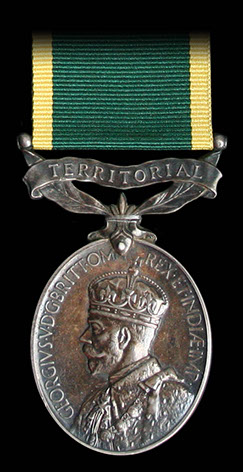
A heavily tarnished Efficiency Medal (T).
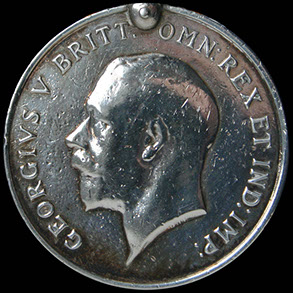
A heavily worn and scratched British War Medal caused by years of polishing & being worn swing mounted beside a 14/15 Star.
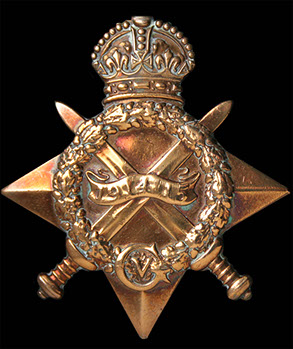
A worn 14/15 Star showing the loss of detail that prolonged polishing can cause.
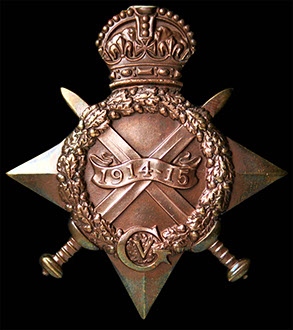
A mint and unworn 14/15 Star.
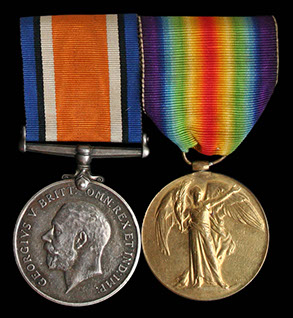
A WW1 pair swing mounted on old ribbons.
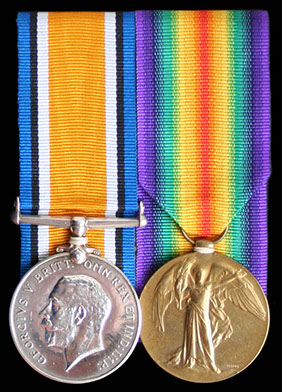
A cleaned and court mounted WW1 pair.

Close up of original issue BWM ribbon.
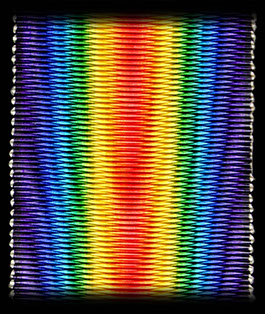
Close up of original issue AVM ribbon.

This site went live on the 14th February 2015 to mark 100 years since the 1/1st Cambs went off to war.
WE WILL REMEMBER THEM
Email us: cambsregt@gmail.com
Copyright 2015, 2016, 2017, 2018, 2019 by Felix Jackson. The information and images on this site should not be reproduced without prior permission.